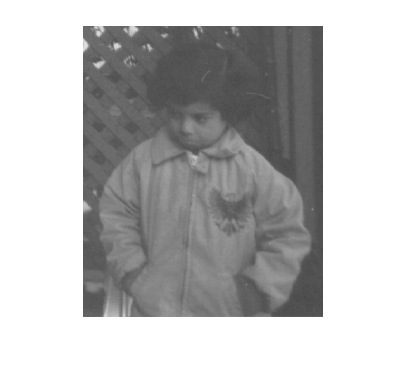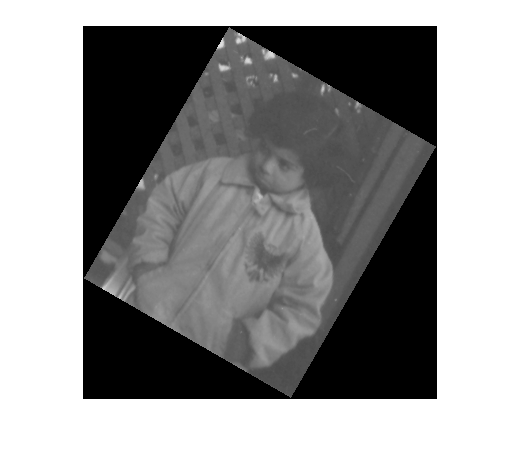invert
Invertir la transformación geométrica
Sintaxis
Descripción
Ejemplos
Lea y muestre una imagen.
I = imread("pout.tif");
imshow(I)
Cree un objeto rigidtform2d que defina una rotación de 30 grados en el sentido de las agujas del reloj alrededor del origen.
translation = [0 0]; theta = 30; tform = rigidtform2d(theta,translation);
Aplique la transformación geométrica directa, tform, a la imagen. Muestre la imagen rotada.
J = imwarp(I,tform); imshow(J)

Invierta la transformación geométrica. El resultado es un objeto rigidtform2d nuevo que representa una rotación de 30 grados en sentido contrario a las agujas del reloj.
invtform = invert(tform);
Aplique la transformación geométrica inversa, invtform, a la imagen rotada J. La imagen final, K, tiene el mismo tamaño, forma y orientación que la imagen original. El relleno negro alrededor de la imagen se debe a las dos transformaciones.
K = imwarp(J,invtform); imshow(K)

Argumentos de entrada
Transformación geométrica, especificada como un objeto de transformación geométrica que aparece en la tabla.
| Objeto de transformación geométrica | Descripción |
|---|---|
| Transformaciones geométricas 2D | |
transltform2d | Transformación de traslación |
rigidtform2d | Transformación rígida: traslación y rotación |
simtform2d | Transformación de similitud: traslación, rotación y escalado isotrópico |
affinetform2d | Transformación afín: traslación, rotación, escalado anisotrópico, reflexión y cizallado |
projtform2d | Transformación proyectiva |
| Transformaciones geométricas 3D | |
transltform3d | Transformación de traslación |
rigidtform3d | Transformación rígida: traslación y rotación |
simtform3d | Transformación de similitud: traslación, rotación y escalado isotrópico |
affinetform3d | Transformación afín: traslación, rotación, escalado anisotrópico, reflexión y cizallado |
Nota
También puede especificar tform como un objeto de tipo rigid2d, rigid3d, affine2d, affine3d o projective2d. No obstante, estos objetos no están recomendados. Para obtener más información, consulte Historial de versiones.
Argumentos de salida
Transformación geométrica inversa, devuelta como un objeto de transformación geométrica del mismo tipo que tform.
Historial de versiones
Introducido en R2013aA partir de la versión R2022b, la mayoría de funciones de Image Processing Toolbox™ crean y realizan transformaciones geométricas utilizando la convención de la premultiplicación. En consecuencia, ahora puede especificar tform como un objeto de transformación geométrica que utiliza la convención de premultiplicación, como por ejemplo un objeto affinetform2d.
A pesar de que invert todavía admite objetos que utilizan la convención de posmultiplicación, como por ejemplo el objeto affine2d, estos objetos no están recomendados. Puede simplificar sus flujos de transformación geométrica cambiando a los nuevos objetos de transformación geométrica de premultiplicación. Para obtener más información, consulte Migrate Geometric Transformations to Premultiply Convention.
Consulte también
MATLAB Command
You clicked a link that corresponds to this MATLAB command:
Run the command by entering it in the MATLAB Command Window. Web browsers do not support MATLAB commands.
Seleccione un país/idioma
Seleccione un país/idioma para obtener contenido traducido, si está disponible, y ver eventos y ofertas de productos y servicios locales. Según su ubicación geográfica, recomendamos que seleccione: .
También puede seleccionar uno de estos países/idiomas:
Cómo obtener el mejor rendimiento
Seleccione China (en idioma chino o inglés) para obtener el mejor rendimiento. Los sitios web de otros países no están optimizados para ser accedidos desde su ubicación geográfica.
América
- América Latina (Español)
- Canada (English)
- United States (English)
Europa
- Belgium (English)
- Denmark (English)
- Deutschland (Deutsch)
- España (Español)
- Finland (English)
- France (Français)
- Ireland (English)
- Italia (Italiano)
- Luxembourg (English)
- Netherlands (English)
- Norway (English)
- Österreich (Deutsch)
- Portugal (English)
- Sweden (English)
- Switzerland
- United Kingdom (English)